#World War II: ETO
Explore tagged Tumblr posts
Text

"Gestapo Informer Recognized by a Woman She Had Denounced, Deportation Camp, Dessau, Germany" (1945) by Henri Cartier-Bresson
Considered one of the most famous photographs of World War II, Herni Cartier-Bresson worked in the French Army's photography unit before being captured by the Nazis in June 1940. While a POW, he attemped escape and on his third attempt was successful. With forged papers, he managed to escape to France.
At end of the war in Europe, he was assigned to the American Office of War Information in May 1945 and given the task of documenting the French POWs and refugees (which would become Le Retour).
Taken at a Dessau deportation camp in East Germany, the camp was a mix of displaced people, forced workers, political and war prisoners, and refugees.
The informer was a Belgian woman who had been a Nazi collaborator and Gestapo informer. She was identified before she could hide in the crowd, and was brought before the camp commandant, Wilhelm Heinrich van der Velden. Wilhelm himself has been nominated to the position by the Americans after being liberated from the Westerbork Camp in the Netherlands.
#History#World War II#World War II: ETO#World War II: European Theater#World War II: Civilians#World War II: Allied Occupied Germany
141 notes
·
View notes
Text
Friends, I have failed you all. I've seen a lot of posts over the last week with a lot of great biographical detail about many of the flyers and aircrew who've been name-dropped so far in Masters of the Air - and I haven't seen a single thing about the one name that is directly in the center of this blog's lane.
In Part 2, returning from their mission to Trondheim, Cleven and Egan walk into the Interrogation hut and Egan accepts a cup of coffee from a woman he thanks as Tatty. Later on, at the dance, James Douglass remarks that he will be 'coming in hot' on one of the American Red Cross women on the other side of the room, and one of his friends asks "General Spaatz's daughter? Or the other one?"
Katherine "Tatty" Spaatz was a member of the American Red Cross Clubmobile service and the daughter of General Carl "Tooey" Spaatz, who commanded the Eighth Air Force on its move to England. (General Spaatz later moved to overall command of the entire Army Air Forces in the Europe Theatre of Operations, or ETO. He is, as the kids say, rather important.)
But we're not talking about him here. We're talking about her.
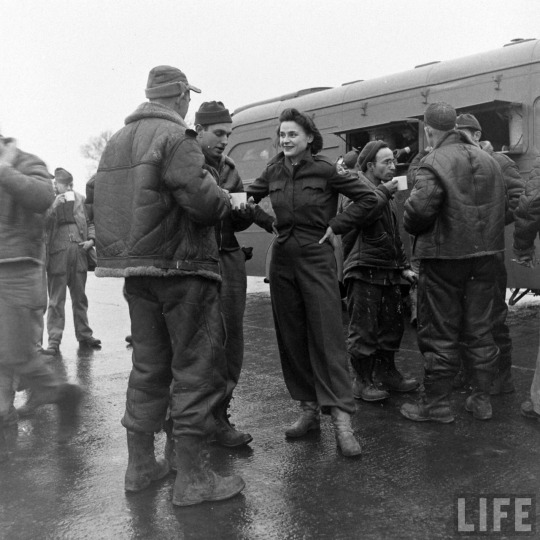
Katherine was 22 years old when she arrived in Europe with the Red Cross. (One of her traveling companions that trip was Kathleen Kennedy, daughter of former U.S. Ambassador Joseph P Kennedy Sr., also coming to serve overseas with the ARC.)
The American Red Cross's mission in Europe had many facets during the Second World War - in addition to activities we might think of today, like collecting blood, providing disaster relief at home and running first aid seminars, they were responsible for collecting and distributing packages for Prisoners of War.
They also operated large canteens like the Rainbow Corner club, a recreational facility in London where soldiers on leave could get a room for the weekend, a bite to eat, and a number of other amenities. Smaller clubs called Donut Dugouts provided a space where a serviceman could always be assured of a cup of hot coffee, a donut, and a pretty girl to talk to, specially recruited for being friendly, fair, approachable, and specially trained to be the girl next door overseas. In addition to these more permanent installations, they also operated the Clubmobile service, a mobile version of their popular Dugouts that moved operations into retooled Green Line Bus Company buses to take donuts and a taste of home to the front line.
Tatty, as she was called, worked on the Clubmobile "North Dakota" along with Julia "Dooley" Townsend, Virginia "Ginny" Sherwood, and Dorothy "Mike" Myrick. Life Magazine did a full article on their clubmobile in February of 1943, which you can read online at the link. There is another lovely blog post with pictures here. She also worked for a time in a more permanent post at the USAAF base at Snetterton Heath, and was later sent to France. You can read a little bit more about her and see more pictures at her bio page at the American Air Museum in Britain website.
If you'd like more information about Tatty, Helen, and women like them, as well as the Clubmobile service, consider reading the following:
Slinging Doughnuts for the Boys by James H. Madison Battlestars & Doughnuts: World War II Clubmobile Experiences of Mary Metcalfe Rexford War through the Hole of a Donut, by Angela Petesch Goodnight, Irene (fiction) - Although this is a novel, it is based on Luis Alberto Urrea's mother's time as a Clubmobile worker and her personal papers.
#women in world war two#women in wartime#original girl gang#american red cross clubmobile service#katherine tatty spaatz#masters of the air#i cannot believe it took me a WHOLE DAMN WEEK
260 notes
·
View notes
Note
I have a potentially strange question, but the search feature on Tumblr leaves a lot to be desired - do you know of any good WWII whump? Specifically that might involve hospital scenes, or takes place in Europe vs the Pacific theater? The WWII movies I know off the top of my head that involve (admittedly brief) scenes in a hospital/dealing with illness rather than injury are Unbroken (Japan) and Hacksaw Ridge (also Japan), The Great Raid (Phillipines), Flags of Our Fathers (Japan again), and Empire of the Sun (Japan and China). If context helps, I'm working on a one shot for Sam Gillespie and Sister Boniface and referencing his time on Sword Beach. (if you haven't seen it, highly recommend - WWII vet DI is besties with a former code-cracking nun who moonlights as the police scientific advisor and the solve crimes and make puns in 1960's Cotswolds).
I can definitely help you here!! I tend to lean more towards watching ETO WWII media myself. And oddly enough a lot of I've watched doesn't have that much whump. Which is weird for a war film/show. But here are some things I'd recommend:
Band of Brothers - follows U.S. Army troops of E "Easy" Company, 506th Regiment of the 101st Airborne Division from their training in England through D-Day and the rest of the war in Europe.
World on Fire - this show follows characters in Warsaw, Manchester, Berlin, and Paris during their lives as the Nazi party begins to take hold of Europe. Season 1 is set from March 1939 to July 1940 and shows events like the Defense of the Polish Post Office in Danzig, the Battle of the River Plate, the Dunkirk evacuation and the Battle of Britain. Season 2 covers October 1940 to May 1941 and shows the North Africa Campaign, The Blitz, Nazi Germany, and Occupied France.
X-Company - follows five recruits as they are trained as agents at a secret Canadian training facility, Camp X near Lake Ontario east of Toronto and then sent out into the field in Europe.
Dunkirk (2017) - This movie is all about the Battle of Dunkirk and the
Atonement (2007) - Allied soldiers from Belgium, the British Commonwealth and Empire, and France are surrounded by the German Army and evacuated during a fierce battle in World War II.
Combat! - a tv series from the 60s that follows a front line American infantry squad as they battled their way across Europe
Saints and Soldiers (2003) - Four American soldiers and one Brit fighting in Europe during World War II struggle to return to Allied territory after being separated from U.S. forces during the historic Malmedy Massacre.
Saving Private Ryan (1998) - Set in 1944 in France during World War II, it follows a group of soldiers, led by Captain John Miller (Tom Hanks), on their mission to locate Private James Ryan whose three brothers have been killed in combat
finally I totally need to watch sister boniface!! that sounds great!
19 notes
·
View notes
Text
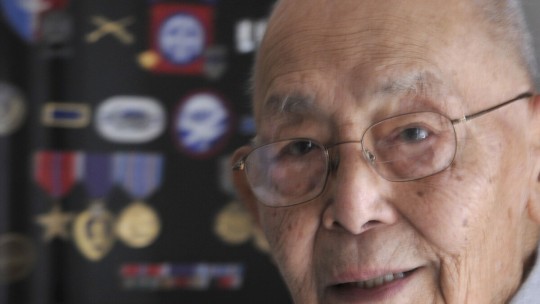
Captain Wesley Ko in front of his decorations for service with the 82nd Airborne Division during WW II. (Photograph courtesy of the Cape Cod Times).
Airborne Chinese American Warfighters on D-Day
On the occasion of the June 6 allied landings at Normandy in 1944, and every National Airborne Day on August 16, we honor three Chinese American veterans of the Second World War.
Glider Infantryman Wesley Ko
Wesley Ko served as a Captain in the 325th Glider Infantry of the 82nd Airborne Division in the European Theater (ETO), earning the Silver Star and numerous other medals including the Purple Heart.
Initially aspiring to be a pilot with the Flying Tigers, Wesley was working in a print shop in Philadelphia when the U.S. entered the war. Despite his employer offering him a draft deferment, he chose to enlist to join his friends. After completing officer candidate school at Fort Benning, Georgia, and overcoming initial delays in assignment possibly due to his Asian ancestry, he joined the 82nd Airborne and subsequently the 325th Glider Infantry Regiment.
During his thirty months of service, Ko fought in six major campaigns including action in Sicily, Naples, Normandy (the day after D-Day), the Battle of the Bulge, the Allied assault on the Siegfried Line, and the battle for Cologne. He was also present at the liberation of the Wöbbelin concentration camp at Ludwigslust.

Capt. Wesley Ko. Ko received the Silver Star for his service in the six major campaigns of the ETO and numerous other medals including the Purple Heart.
In his later years, Ko dedicated his time to preserving the legacy of the 325th Glider Infantry. He shared his experiences through interviews, articles, and books such as The Greatest Generation and his biography On Silent Wings of Courage. He also served as editor of The Glider Tow Line, a quarterly newsletter dedicated to the glider men's stories.
In addition to his military service, Ko co-owned and operated Komak, Inc., an electronics company, with his brother David for 45 years. He had a wide array of interests including computers, boating, fishing, family, poetry, and furniture re-finishing and building.
Ko passed away in E. Falmouth, Mass., on Dec. 15, 2012. He was 93.
Leon Yee: San Francisco Chinatown’s Own
On the night of June 5, 1944, private First Class Leon Yee had found his way onto a paratroop transport plane, flying toward the coast of France. Having grown up in San Francisco Chinatown, Yee had volunteered for the paratroopers in early 1942. He had been motivated by the $50 bonus in hazardous duty pay, which he needed to support his family. After completing jump school at Fort Benning and earning his wings in mid-1942, he trained as a demolition expert and member of H Company in the 507th Parachute Infantry Regiment of the 82nd Airborne Division. According to Chinese American military historian, Montgomery Hom, Yee had concealed from his family how dangerous his duties were. “He tried to hide his combat status by telling his mother he was going to be working with planes,” Hom has written. “But in truth, he was going to be jumping out of planes as an airborne soldier.”
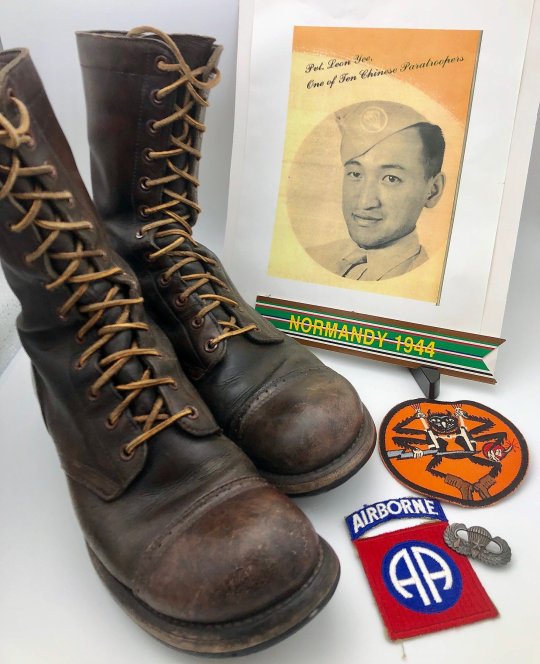
Leon Yee's jump boots, unit patches, and jump wings (from the collection of his nephew and documentarian, Montgomery Hom). The boots were designed initially in 1941 by William P. Yarborough, a test officer in the 501st Parachute Infantry Battalion/Provisional Parachute Group. They are also known as "Corcorans," after the J. F. Corcoran Shoe Company, one of their manufacturers.
At approximately 0200 on June 6, and as part of the then-largest airborne operation in human history, Yee hurled out of his plane, weighed down by more than 100 pounds of equipment, As he descended, he saw sporadic gunfire and small fires on the ground. He landed in a cow pasture northwest of the Merderet River, disoriented in the pitch-black night. under the cover of darkness. German anti-aircraft fire illuminated the sky, hitting some of the aircraft.
After landing without mishap and shedding his parachute harness, Yee took cover in a nearby ditch. He had no idea of his location, as his regiment had experienced the worst drop pattern of all the American airborne units, with only 20% of the paratroopers landing in their designated zones. Hours later, by 4 a.m., a helmetless sergeant from another company of the 82nd Airborne Division joined him. Together, they sat quietly in the ditch until dawn, trying to determine their location. They discovered they were north of their intended drop zone.
By daylight, Yee had joined other regrouped paratroopers regrouped to plant explosives to destroy enemy communication lines, and engage in firefights as elements the 82nd advanced over the next few days toward their main objective, about 5 miles from Utah Beach -- the marshes of the Merderet and Douve. The marshes formed a natural defensive line protecting the western end of the Allied amphibious landing zone. However, the flooded marshes also limited the Allies' potential to break out of the beachhead. They had been flooded to further impede movement. Allied planners deemed control of the bridges at Manoir de la Fière and Chef-du-Pont as vital.
Yee's ad hoc unit reached the La Fière area, and over the next five days attempted to seize causeways and bridges over the Merderet at La Fière and Chef-du-Pont and, further, destroy the highway bridge over the Douve River at Pont l'Abbé (now Étienville). The lightly-armed troops of the 82nd faced counterattacking Wehrmacht units supported by Panzer III and French tanks captured four years earlier.
Yee would see intense combat for five days. During an attack on a German machinegun position, he was severely wounded. A burst of gunfire had struck rocks in front of him, and a ricocheting fragment hit his right temple, just below his helmet. Bleeding profusely from his wound, he lost consciousness. Yee awoke on a cot in a landing craft headed back to England.
Paratrooper Kenneth Gong
On the eve of D-Day Kenneth Gong, a native Chinese American from the town of Cleveland in the Mississippi Delta, performed the first of his two combat jumps, with the 101st Airborne Division.
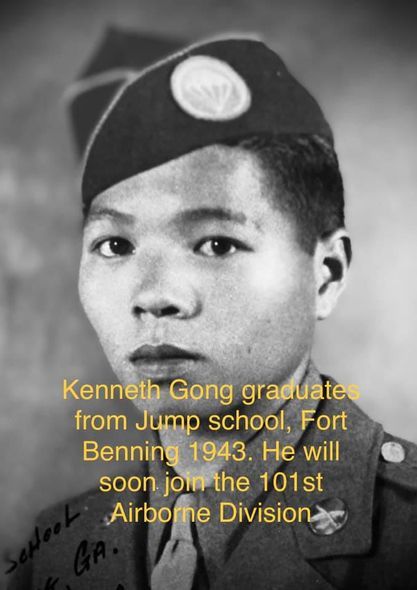
Sgt. Kenneth Gong of the 101st Airborne Division was a native of Cleveland, Mississippi.
Kenny Gong had earned the nickname “Machine Gun Gong” for his proficiency in firing the M3 submachine gun.
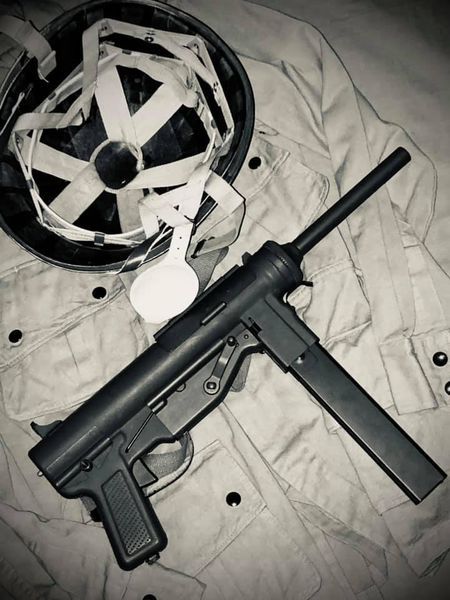
The M3 is an American-made, .45-caliber submachine gun adopted by the U.S. Army in late 1942, as the "United States Submachine Gun, Cal. .45, M3." The M3 was chambered for the same .45 ACP round fired by the Thompson submachine gun, but was cheaper to mass produce and lighter, at the expense of accuracy. Troops commonly referred to the firearm as the "Grease Gun" or "the Greaser" owing to its visual similarity to the mechanic's tool. The weapon is often attributed as the source of the WW II slang used by American soldiers in referring to enemy troops killed by this weapon, who were referred to as having been "greased."
T-4 Sergeant Gong was assigned to the headquarters command, 3rd battalion, 501st Parachute Infantry Regiment, 101st Airborne Division. He saw combat in Normandy and Holland.
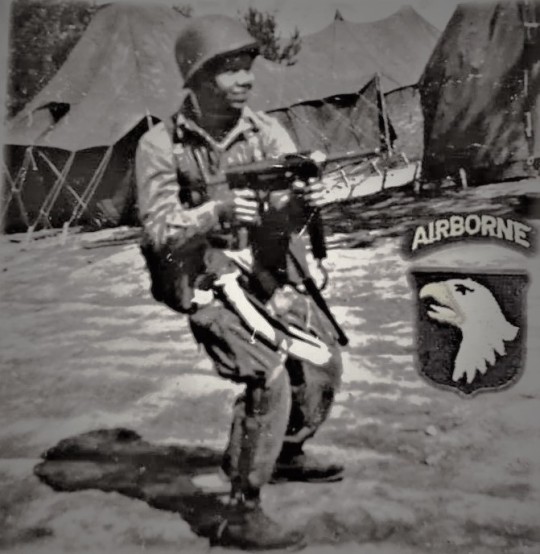
Sgt. Kenneth Gong of the 101st Airborne Division brandishing the M3 submachine gun, his handling of which would earn him respect from his comrades.
When US president Bill Clinton proclaimed October 26, 1998, Chinese Veterans of World War II Day, longtime Delta resident Kenny Gong was one of the White House honorees. His division’s motto remains “Rendezvous With Destiny.”
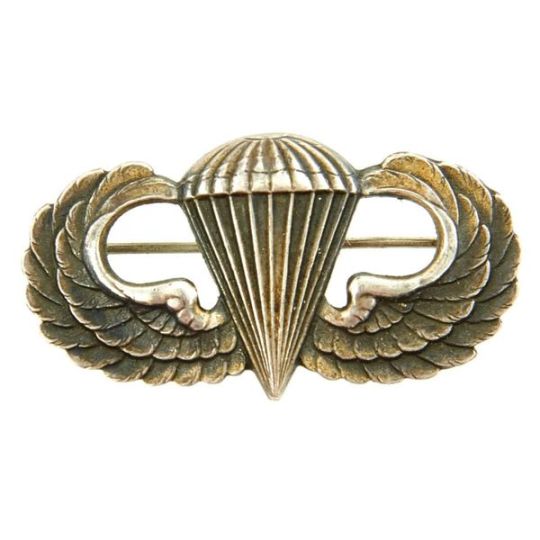
The Parachutist Badge, also commonly referred to as "Jump Wings," is a military badge of the United States Armed Forces. Some services, such as the Marine Corps, officially refer to it as an insignia instead of a badge. The original Army Parachutist Badge was designed in 1941 by Captain (later Lieutenant General) William P. Yarborough and approved by the Department of War in March of that year. The Parachutist Badge replaced the "Parachutist Patch" which had previously been worn as a large patch on the side of a paratrooper's garrison cap. (LTG Yarborough also designed the Senior and Master Parachutist Badges and the addition of stars to portray the number of combat jumps.) The airborne background trimming that is worn behind the badge of those assigned to airborne units is also a contribution of Yarborough.
On this 80th anniversary of the airborne landings in Normandy, let us honor not only the approximately 10 Chinese Americans who served with paratroop and glider units in the European Theater of Operations but all who answered the call to fight for their country during an era of exclusion and segregation.
They also served.
---------------------------------
To read more about Chinese America's warfighters of that era from California, Montgomery Hom's book Fighting on all Fronts - Profiles of WWII Chinese Americans from the Golden State may be purchased here.
#Chinese American airborne troopers#Kenneth Gong#101st Airborne Division#Wesley Ko#82nd Airborne#Leon Yee#Montgomery Hom
3 notes
·
View notes
Text
EagleCals #188 P-38 Lightnings in Europe
EagleCals Releases New P-38 Lightning Decals EagleCals Editions has released a new set of decals for the P-38 Lightning fighter aircraft. The decals are available in 1/72, 1/48, and 1/32 scale, and they represent four different P-38s from the European Theater of Operations (ETO) during World War II. The four P-38s that are represented in the set are: P-38J-15LO “W” of the 479th Fighter Group,…

View On WordPress
0 notes
Text
The 474th Infantry Regiment was comprised of soldiers from the 1st Special Service Force; what remained of the 1st, 3rd, and 4th Ranger Battalions; and the 99th Infantry Battalion, a unit comprised of entirely Norwegians and Norwegian-Americans. The 1SSF and Rangers became the 1st and 2nd Battalions of the 474th, nothing special about them besides their lineages. The 99th was technically the 3rd Battalion, but as they hadn't done anything wrong, they requested and were allowed to keep their unique designation. So, the 474th was comprised of 1st, 2nd, and 99th Battalions.
To the modern mind the idea of entire elite Ranger units being converted into a regular army unit sounds impossible.
But at that time, the Army had no real distinct lineage of 'Special Forces.' Nobody had so solidly connected any Revolutionary War hero or the light infantry companies used in the conflict so well to the Rangers that they seemed like a concept that had 'always existed.' Sure, precedence, but no, the Ranger concept was very new and the US Army was fucking sick of it at the end of 1944. The army was sick of the entire concept of special elite units, in fact.
They were having trouble with Airborne units claiming they were too elite to ‘waste’ fighting on the frontlines (somewhat true, the 82d's members had battle exhaustion that hindered their effectiveness in Market Garden, and by the end of the Bulge both they and the 101st were spent). The Canadians stopped supplying reinforcements to the 1SSF, and the 1st, 3rd, and 4th Rangers became replacement fodder for them. Those Rangers were falling apart at the seams - they had just kind of imploded after Normandy, having been in an organisational tailspin since the Battle of Cisterna obliterated the 6615th. Almost a third of what Rangers remained were wounded, a third more went AWOL drinking, fucking, and fighting their way through liberated France, and the remaining third’s morale was rock bottom. Becoming a regular unit was the only way to restore morale and make any use of them. Only the 2nd and 5th Ranger Battalions actually made it through the war as their own entities in the ETO (the 6th was in the Pacific).
No Ranger units survived 1945 - disbanded at the end of World War II. Because the Army had learned that the elite unit was more trouble than it was worth. Unfortunately for us all, Rangers got reactivated in 1950 for the Korean War and we've never been fuckin rid of them since
I think the fact that the Rangers literally got disbanded during WWII because at one point what remained of them were 1/3rd available, 1/3rd in the hospital, and 1/3rd AWOL fighting and fucking everyone in liberated France, and forced to become a normal infantry regiment (the 474th Infantry Regiment) was a very based choice actually
65 notes
·
View notes
Photo
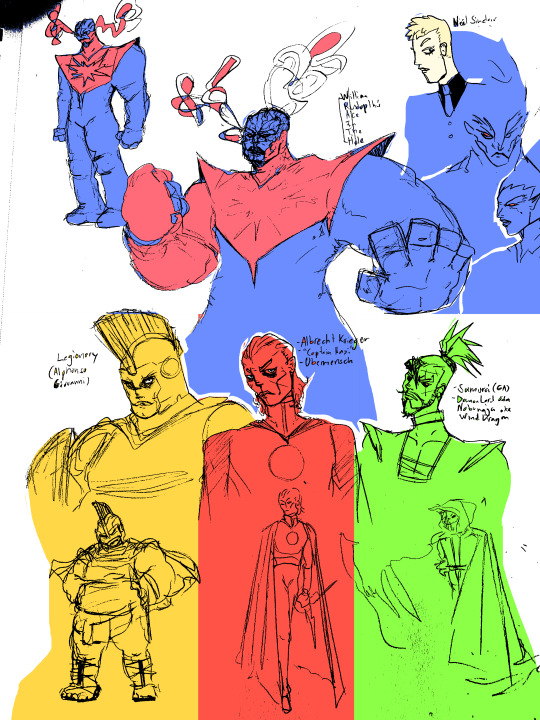
sketchpage headverse update, World War II era:
so originally, I was just gonna do Wraith, but ended adding Neil Sinclair/Subject Zero from Project: Superman and a metahuman each for the Axis Powers.
Wraith: arriving on Earth in response to a mathematical SOS Formula, Wraith quickly found himself at odds with Wonder Woman and the Justice Society over differing ideas on justice and how to best protect humanity, mostly from itself. This culminated in a bloody, drag out brawl between Wraith and Diana in Japanese Airspace, as she did everything in her power to prevent the alien “hero” from slaughtering hundreds of thousands of innocent Japanese civilians. While she was distracted, the US military would drop the first atomic bomb on Hiroshima, largely proving Wraith’s point. Once the second bomb dropped on Nagasaki, Diana gave up on Man’s World yet again, and vanished. Wraith returned to his base—The Machine—and waited for her to return.
So obviously a couple big changes here, mostly that Wraith was a. known to the public in 1945 and b. a Wonder Woman villain circa the Golden Age instead of a Superman villain/ally (?) in the modern day. I don’t think I ever actually finished Unchained because every time I try to read it my eyes kinda glaze over. Wraith does emerge in the modern day, now in connection with Neil Sinclair (now William Rudolph’s other grandkid), who instead of getting modified with Kryptonian DNA, gets metagene therapy from Wraith. They develop a sort of parent-child bond, as Wraith does what he can to train Neil and curb their more vicious instincts heightened by their new powers.
of the Axis characters, Legionary is an Italian hero who’s actually at odds with Mussolini’s government and trying to protect civilians from both the Italian and American militaries. He’s Alphonso Giovanni, the Batmen of All Nations member, though in this version he was always a heavy guy bc idk I think more fat superheroes would be cool and I think the shorthand of “Legionary got heavy and lazy/complacent and that gets him murdered” is…not great. He does still eventually get Merc’d by a Black Glove operative, but that’s more to do with his advanced age and he puts up a good fight before he goes.
Ubermensch—known in America and Britain as Captain Nazi—is Albrecht Krieger, a ten year old Hitler Youth who was selected by High Command’s occult division to receive the “blessing” of a shard from the Rock of Eternity, provided by Vandal Savage. Albrecht is a fervent Nazi, well aware of the Final Solution, and generally just a fucking monster. He actually gets progressively worse as the war comes to end and after, thrown through the Bleed in pursuit of Shazam, coming into contact with his new masters, the Eternal Reich of Earth-X.
The last character here…is complicated. While Asami Koizumi is the modern Samurai, there was a Golden Age Samurai: the Demon Lord Oda Nobunaga. Revived in the early days of the war, Oda currently actually travel too far beyond the Japanese Archipelago without risking a return to his deceased state. Being largely uninvolved with the war effort was frustrating for the revived daimyo, who instead focused his efforts on exploring mysticism and Buddhist tenets in an effort to increase his power and gain the capacity to explore the wider world. He came into conflict with Wraith as well, their so-called “War of Demons” being among the most destructive meta human battles in the Pacific Theater. It was Diana’s selfless attempt to join their final fight that allowed Oda to realize the truth of himself: Oda Nobunaga had been dead for centuries, he was merely a revenant with that man’s face. Wind Dragon, the man who had abandoned his past, sealed his himself away. A young history student, Toshio Eto, would discover the Wind Dragon years later and use its power to become the Silver Age Samurai, before his student, a meta human named Asami Koizumi, would succeed him in turn.
#dc#headverse#fanart#wraith#neil sinclair#subject zero#william rudolph#legionary#alphonso giovanni#ubermensch#captain nazi#albrecht krieger#samurai#wind dragon#oda nobunaga#toshio eto
14 notes
·
View notes
Text
Ronnie Bell Following
P-51 Mustang
An airman of the111th Tactical Reconnaissance Squadron, attached to the 9th Air Force with his F-6 Mustang nicknamed "Darlin' Presh". F-6C Mustang (CL, serial number 42-103403) is in the background. , With the onset of World War II, the unit was called into federal service 25 November 1940 and trained with the 36th Division at Brownwood Airfield Texas until Pearl Harbor was bombed, it was sent to the Mexican border, Fort Clark Springs Texas. The border patrol was short, and on 14 February 1942, the squadron left Texas for Daniel Field in Augusta, Georgia, and became part of the 68th Observation Group. Pilots trained on Douglas O-43A, Vultee/Stinson O-49/L-1 Vigilant and Douglas A-20B Havoc aircraft in preparation for deployment to the European Theater of Operations (ETO).
In 1942 the ground echelon and some pilots made their way to Scotland then England in preparation for landing on the Algerian beaches as part of Operation Torch, their shiny new P-39 Airacobra's had to be assembled and tested before flying from England to Algeria. Some of the pilots of the 68th Group flew their A-20s directly across the Atlantic on the "Southern Route" and immediately began flying over the Mediterranean in anti-submarine patrols, sinking at least one submarine. As the invasion force moved inland, the three squadrons of the group divided up the A-20s and P-39s by squadron and the 111th took on the Fighter Reconnaissance role in the P-39.[citation needed]
In March 1943, the 111th left the 68th Group to defend against a possible invasion of French Morocco from Spanish Morocco while the rest of the group was selected to support the Tunisian Campaign of the Army’s II Corps. In June 1943 the newly redesignated 111th Tactical Reconnaissance Squadron, flying Allison engined F-6A or F-6B Mustangs (taken from a British order of Mk IAs), became the eyes of the 7th Army in Sicily, Operation Husky. They were temporarily assigned to the 5th Army in Italy, but returned in July 1944 in time to support the 7th Army’s invasion of southern France, Operation Dragoon. In addition to the older F-6A/F-6B Mustangs, they began receiving F-6C Mustangs (the photo recon version of the P-51C). The 111th remained with the 7th Army through the end of the war. From VE Day until December 1945, the Squadron served in the occupation force, and conducted postwar photo-mapping of the devastation in France.
During 23 months of continuous combat flying, from June 1943 through May 1945, the 111th Tactical Reconnaissance Squadron flew 3,840 reconnaissance missions. While keeping Army Headquarters informed of enemy movements, the 111th destroyed 44 enemy aircraft, damaged 29 others and claimed 12 probable kills. The squadron received eight Battle Stars, a Distinguished Unit Citation, and the French Croix de Guerre for its World War II accomplishments
Via Flickr
3 notes
·
View notes
Text
Foundation: Why Isaac Asimov’s Estate Approved Modernizing the Sci-Fi Classic
https://ift.tt/3EKbwIq
This article contains no spoilers for Foundation.
We live in an era when classic works of literature that were once thought to be “unfilmable” — particularly in the realms of sci-fi and fantasy — are now actually coming to the screen. Chief among those, and certainly a crown jewel in the annals of science fiction, is Foundation, an epic series of stories and novels by legendary writer Isaac Asimov that spans thousands of years of future galactic history.
Premiering on Apple TV+ with a 10-episode first season, Foundation begins with the story of Hari Seldon (played by Jared Harris), a mathematician who develops a science called psychohistory, with which he can predict large-scale patterns in history and human behavior. Not surprisingly, Seldon’s prediction that the vast Galactic Empire will collapse into a 30,000-year period of barbarism doesn’t sit well with the Cleons, clones of the original emperor, Cleon 1, who have ruled the galaxy for more than 400 years.
Seldon’s plan is to establish the Foundation, a repository of knowledge that can help cut the coming dark ages down to 1,000 years. The Cleons allow him to proceed, but banish him and his followers to a distant planet called Terminus where they will set up the Foundation. Key to Seldon’s plan are a brilliant young woman named Gaal Dornick (Lou Llobel), his adopted son Raych (Alfred Enoch) and, years later, Salvor Hardin (Leah Harvey), the warden and protector of the colony on Terminus.
Series creator/showrunner David S. Goyer — known to fans for writing the original Blade trilogy, co-writing the screenplays or stories for the Dark Knight trilogy and Man of Steel, creating Da Vinci’s Demons for TV and much more — tells Den of Geek that he had been approached in the past about adapting Foundation as a feature film, but finally jumped at the opportunity to develop it in the present era of long-form streaming. But that doesn’t mean Foundation wasn’t difficult to adapt anyway.
“The original novel or series of short stories was written in the late ‘40s, early ‘50s,” he says. “So the key was identifying the core themes and figuring out, okay, that was what Asimov was writing about in a post-World War II environment. What’s the world like today and how can we apply what’s happening today to the metaphors of Foundation now?”
Other roadblocks to adapting Foundation in the past (which has defeated filmmakers such as Roland Emmerich and Jonathan Nolan, who were developing it for Columbia Pictures and HBO respectively at different points) were the vast leaps in time that the books make as well as their generally cerebral, complex nature. But Goyer had other concerns.
“I thought the harder aspect was making it emotional,” he explains. “The books aren’t known, per se, for being emotional, but with television, people tune in for emotion and characters. So I had to figure out ways of taking Asimov’s themes and embodying them into characters that could express those themes, through love, through their relationships with their parents and children, and so forth.”
One solution to that — and to updating Foundation for audiences in the 21st century — was to make alterations to a number of the major characters, like Salvor, Gaal and the Cleons’ android right hand person Eto Demerzel (Laura Birn), almost all of whom are male in Asimov’s books. But Goyer says he first wanted to make sure his proposed changes met with the approval of the late Asimov’s daughter Robyn and the Asimov literary estate.
Read more
Sponsored
How Foundation Brings the Asimov Novels to Life on Apple TV+
By Michael Ahr
TV
Is Foundation Apple’s Answer to Star Wars?
By Michael Ahr
“The first question that I posed to the Asimov estate was, given that this was written in a post-World War II environment, where there were virtually no speaking female characters in the first book, where very few members of the science fiction community or readers were women, was, ‘We’re going to be doing this for an audience of today and I want the characters in the show to reflect our audience. How do you feel about gender swapping some of the characters?’” he recalls. “Robyn Asimov and the estate completely embraced it. They said that Asimov himself would have embraced that and they were absolutely comfortable with that.”
Goyer also made other, extensive changes to the narrative, such as creating the Cleons (who are played at various ages by Lee Pace, Terrence Mann and Cassian Bilton) and developing storylines that would add the kind of action, intrigue and space opera necessary to keep audiences involved for 10 hours. Goyer says that every step of the way the Asimov estate was on board.
“Look, I grew up on these books, I revered the books,” says Goyer, whose introduction to Foundation and sci-fi came at a young age through his estranged father. “Like a lot of people, Asimov meant a lot to me. A lot of people have a very personal relationship to the original Foundation trilogy — it’s kind of this hallowed piece of work. It was important to me that Robyn and the estate felt like we were doing Asimov’s work justice and that we understood what the themes were about.”
He adds that the estate and Robyn Asimov were “very happy” after reading the first two scripts and seeing the first two episodes: “We felt that we had embraced everything that was important about Foundation and changed the things that, they felt as well, had to be updated for the time.”
The irony of this, even some 60 years after the first Foundation novel was published, is that Goyer sees the overall story, subject matter and themes as more relevant and prescient than ever.
Apple TV+
“I started on this project three years ago,” he says. “Certainly climate change was something that people were talking about, but it hadn’t reached this critical juncture where we’re at now. We weren’t involved in a global pandemic and we weren’t involved in this crazy factionalism and this rise of nationalism that we’re seeing.”
Goyer says that it took him several readings over the years for the books to finally grab hold of him, and that he also passed on adapting it for the big screen twice before. So what made this the right time? “Now that I’m a father, I find myself thinking a lot more about what the world of tomorrow will be like, what the legacy that we leave our children and grandchildren will be,” he responds.
cnx.cmd.push(function() { cnx({ playerId: "106e33c0-3911-473c-b599-b1426db57530", }).render("0270c398a82f44f49c23c16122516796"); });
“That’s a lot more important to me now than it was before I was a father,” Goyer continues. “A lot of those themes carry through in the books, but also in our show. It’s kind of about, what are you willing to sacrifice now, so that future generations, our children and grandchildren, will be able to live in a world that’s as amazing as the world we live today? What is today willing to give up for tomorrow?”
The first two episodes of Foundation premiere Friday (September 24) on Apple TV+, with future episodes debuting weekly.
The post Foundation: Why Isaac Asimov’s Estate Approved Modernizing the Sci-Fi Classic appeared first on Den of Geek.
from Den of Geek https://ift.tt/3kB5zW4
4 notes
·
View notes
Text
MASTERLIST
[Shoot me an ask to be added to any taglists!] [All my fics are now locked. Create an account on AO3 if you cannot access them.]
.
Sister-in-Arms (BoB) | AO3
PART I: RUN THE GAUNTLET
All events leading up to the Day of Days, from June’s arrival, tests of fortitude, withstanding Sobel, to earning her Jump Wings. Ends on the Upottery Base, June 5. Eventual pairing; mostly gen. Updates every couple weeks.
Everything related to the behind-the-scenes of SiA is #SiA
Author’s note
June illustration
Another (better) one
Chapter 1: Toccoa, GA
Chapter 2: The Camp
Chapter 3: Mess
Chapter 4: Sobel
Chapter 5: Saturday
Chapter 6: Doing Time
Chapter 7: Currahee
Chapter 8: Drills
Chapter 9: Men Without Women
Chapter 10: Powder Barrel
Chapter 11: Avoidance
Chapter 12: Hibiscus
Chapter 13: Back Again
Chapter 14: The Long Weekend
Chapter 15: Titrant
Chapter 16: Out of Hand
Chapter 17: Holes
Chapter 18: Contraband
Chapter 19: A Little Louder than Silence
Chapter 20: Second Page Girl
Chapter 21: Epicene
Chapter 22: Like Spinning Plates
Chapter 23: The Post Exchange
.
Firebird (HBO War) | AO3
Brief stories of a fiery pilot whose adventures take her to far-flung corners of both Allied theaters. Gen. Currently on hiatus.
Part I: Target Practice
Part II: When the Living is Easy
.
War in the Time of Death (BoB) | AO3
A zombie AU. Or, alternatively: how would the WWII ETO have played out if the dead didn't die? Gen.
Chapter 1: Nosferatu
.
Once More Unto the Breach (BoB)
A collection of Easy Company rarepair interactions, transplanted into a colder, equally hostile world of glacial dreams and directionless depths. Gen. Crossover AU with The Terror.
Part I: Red
.
MISCELLANEOUS
(NOTE: I don’t write x reader fics anymore)
Speir(s) [crack] | AO3 + illustration
A crack-y discussion about the name Speirs, and what it implies.
Asclepius [Reader insert / Roe] | AO3
It is winter in Bastogne and you wish for a different time.
Halcyon [Reader x Shifty] | AO3
There is the forest, and an indescribable feeling of vitality. It doesn’t take long for you to realize the source of life is your proximity to Shifty.
Momentary Warmth [Reader x Skip] | AO3
Deep in the snowed-in forests of Bois Jacques, you are trapped in the network of trees and ice. Refuge is found in the form of foxholes.
Never Done [Reader x Eugene Sledge] | AO3
There is a bomb and then they say there is peace. You do not feel it.
.
COMMENTARIES
On POC and Fics - Or, why June is white
What it means to be a creative
.
(No disrespect is meant to WWII veterans. All HBO War transformative work is based on characters portrayed in the shows, not the real people)
30 notes
·
View notes
Text
On Easter Sunday 1945, Harry Stewart Jr. and his wingman, Walter Manning, were part of a mission to escort a B-24 Liberator bombing mission over St. Polten, Austria. They were both members of the 332nd Fighter Group, the famed Tuskegee Airmen. While the legend that they never lost a single bomber isn't true, they were particularly good at their jobs; when the bombing mission ended, seven of the 332nd's escort fighters flew on to hit targets of opportunity as the B-24s headed home.
As they flew along the Danube River, nearly a dozen fighters appeared. In the dogfight that followed, Stewart would rack up three kills, and 10 of 12 enemy ambushers went down in all. But the Tuskegee Airmen lost two of their own. Manning was one of them. When all was said and done, Stewart would receive the Distinguished Flying Cross. Manning would be captured and lynched by enemy civilians.
Those were the stakes for America's first-ever Black combat pilots. But Stewart would survive World War II as one of only four Tuskegee Airmen with three air-to-air victories in a single day, leading a storied Air Force career before leaving active duty in 1950.
Stewart died on Feb. 2, 2025, at his home in Bloomfield Hills, Michigan. He was 100 years old.
#History#World War II#World War II: US Army Air Force#World War II: ETO#World War II: European Theater#World War II: Tuskegee Airmen#World War II: Red Tails#the US Air Force has been told to stop teaching about the Tuskegee Airmen but honestly that directive can fuck off
24 notes
·
View notes
Text
Review of Netflix's ‘The Liberator’

So, the internet’s been abuzz with Netflix’s new series, “The Liberator.” I was excited, as well, as it followed the story of a US Army infantry division in the Second World War. It was a great idea. We’ve seen everyone else get their due - Band of Brothers, Saving Private Ryan, Red Tails, The Pacific, Fury - the list goes on and on. But the regular leg infantry really hasn’t gotten their screen time.
I, therefore, sat down late last week and watched the entirely binge-able 4-episode miniseries. They’re about an hour each, and the animation was an interesting twist. It took some getting used to, but with things like anime and graphic novels being big with younger generations, I think this was a good series to introduce younger viewers to a “dogface’s” view of the Second World War.
I also liked the division they picked. The 45th Infantry Division was part of the Oklahoma National Guard, and as Mike Rowe put it, the makeup of the division was “…at first Mexicans, Native Americans, and Cowboys.” What they didn’t mention, but perhaps should have, was as the war went on, and more and more draftees filled the ranks of the US Army, the National Guard divisions like the 45th lost their regional character. It’s a small thing, but I think they demonstrated it with Vaccaro, the character who shows up in episode 3 from Chicago, but it could have been illustrated better.
Overall, that seems to be the tone of the series. A for effort, C for results. The show could have used the help of someone like Dale Dye. First off, the rank insignia on the front of the helmets would have been gone by the time the 45th as a whole hit Italy. Those rank insignia make great aiming points for German snipers! Most units in the ETO went with a bar system to the rear of the helmet, a horizontal white bar for NCOs, and a vertical white bar for officers.
youtube
I was a little skeptical of the main character being as far forward as he was as even a company commander. I get story demands, but I really wish they’d centered the story around the Native American NCO. I get it. He didn’t write the book that the series is based on, but when you have a major acting like he’s a second lieutenant, my ability to stretch reality is a bit strained.
At times, I thought the terminology was made-up because the writers didn’t know the real terminology. The MP scene at Anzio had me cringing, not to mention the German assault during the episode. It more resembled a human wave assault you’d see from the Japanese or the Russians, and not the fire and movement we’d see from a German-style assault. I also didn’t see any German machine guns till the third episode. And every German soldier, with the exception of one (the German Major in the Anzio episode) was SS, which makes me wonder an aside? Why is every German in a WWII movie a member of the Waffen-SS? It’s a pet peeve of mine. And then there was the 60mm mortar killing a tank. Trust me, it’s not going to happen.
That’s not to say there were not elements I did like. I thought the episode with Aschaffenburg and Dachau (especially the gruesome beginning) was very well done (things like that happened as Germany collapsed at the end of the war). The scene in the coal yard at Dachau - it actually happened.
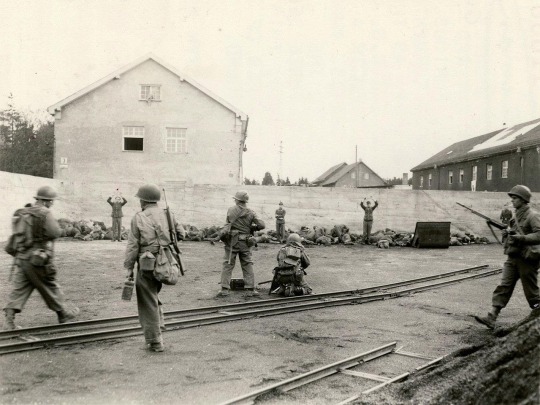
They did a good job of showing not just the incident but the aftermath, and yes, Patton was rather sanguine about it. As he was the military governor of Bavaria, he chose to dismiss it, and yes, our character, Felix Sparks was almost court-martialed, as the show demonstrates. But again, I felt the story was a bit rushed and didn’t explain as well as they should have the true revulsion of the troops involved.
My own Grandfather’s division, the 4th Armored, liberated Ohrdruf Concentration Camp, was part of Buchenwald. The sight was, to say the least, ghastly, and I won’t go into details here. What I will say is I asked him about this photo and incident once. He said to me simply, “Jay boy, we weren’t that dumb. We simply gave the prisoners lead pipes, locked the SS guards in a room with them…and whatever happened…happened.”
I think Netflix overall made a good effort, but the series was too short, and there were more than a few details that could have been done better. All in all, I don’t think the audience for this show is those of us who know and study World War II, but the younger generations who didn’t know veterans of the conflict. I think for them, this is a worthy thing to watch. Still, I’d also have them read books like Beyond the Beachhead, Patton’s Vanguard (admittedly, this one is a view of an entire armored division, rather than an infantry division like the 45th, but the writing is solid), and When the Odds Were Even.
My main complaint: The series needed four more episodes to do itself right. I just felt the story was too rushed and too choppy at times. I get a lot of the constraints, but I am always of the opinion, “if you’re going to tell a story like this, tell it right.” I think Netflix missed an opportunity here, with an innovative medium, no less. I am hoping someone takes up the baton and gives both the tech and the subject manner the respect they deserve.
--
At SJR Research, we specialize in creating compelling narratives and provide research to give your game the kind of details that engage your players and create a resonant world they want to spend time in. If you are interested in learning more about our gaming research services, you can browse SJR Research’s service on our site at SJR Research.
--
(This article is credited to Jason Weiser. Jason is a long-time wargamer with published works in the Journal of the Society of Twentieth Century Wargamers; Miniature Wargames Magazine; and Wargames, Strategy, and Soldier.)
1 note
·
View note
Text





ETO M4 Tanks and Tank Crewmen in World War II
48 notes
·
View notes
Text
Lieutenant Frances Y. Slanger was an Army nurse serving in the ETO in Belgium. She wrote this letter to the military newspaper Stars and Stripes at 2:00 A.M., from “Somewhere in Belgium,” on October 20, 1944:
It is 0200, and I have been lying awake for one hour, listening to the steady, even breathing of the other three nurses in the tent ... I am writing this by flashlight ... The GIs say we rough it. We in our little tent can’t see it. True, we are set up in tents, sleep on cots and are subject to the temperament of the weather. We wade in ankle deep mud. You have to lie in it. We are restricted to our immediate area, a cow pasture or a hayfield, but then, who is not restricted? We have a stove and coal. We even have a laundry line in the tent ... What with the wind howling, the tent waving precariously, the rain beating down, the guns firing, and me with a flashlight, writing. IT all adds up to a feeling of unrealness.
Sure, we rough it, but in comparison to the way you men are taking it, we can’t complain ... you, the men behind the guns, the men driving our tanks, flying our planes, sailing our ships, building bridges and to the men who pave the way and to the men who are left behind - it is to you we doff our helmets ... After taking care of some of your buddies, comforting them when they are brought in bloody, dirty with the earth, mud and grime, and most of them so tired. Sombody’s brothers, somebody’s fathers, and somebody’s sons, seeing them gradually brought back to live, to consciousness and to see their lips separate into a grin when they first welcome you. Usually they kid, hurt as they are. It doesn’t amaze us to hear one of them say, “how ‘ya babe,” or “holy mackerel, an American woman,” or more indiscreetly, “how about a kiss?”
...We have learned a great deal about our American soldier, and the stuff he is made of ... The patience and determination they show, the courage and fortitude they have is sometimes awesome to behold. It is we who are proud to be here. Rough it? No, it is a privilege to be able to receive you, and a great distinction to see you open your eyes with that swell American grin, say “Hi ‘ya babe.”
(Just one day after writing and sending that letter Lieutenant Slanger was killed by German shell fire ... she was one of sixteen nurses killed overseas during World War II as a result of enemy attacks ... One soldier pointed out, in what remains a poignant eulogy to her spirit, that nurses volunteered, while enlisted men were drafted. His reply to Slanger might also stand as a tribute to every woman who volunteered in World War II, in both military and civilian service.)
To all Army nurses overseas: We men were not given the choice of working in the battlefield or on the home front. We cannot take any credit for being here. We are here because we have to be. You are here because you felt you were needed. So, when an injured man opens his eyes to see one of you ... concerned with his welfare, he can’t but be overcome by the very thought that you are doing it because you want to ... you endure whatever hardships you must to be where you can do us the most good.
-Emily Yellin, Our Mothers’ War
12 notes
·
View notes
Text

The 6888th Battalion Was The Largest All Black Female Military Unit In World War 2
The 6888th Central Postal Directory Battalion was a unique U.S. Army unit and it had the distinction of being the only all-African American, all-female unit sent overseas during World War II. The women kept mail flowing to nearly seven million soldiers in the European Theater of Operations (ETO).
With approximately 850 officers and enlisted personnel, this Women’s Army Corps (WAC) unit was organized into four postal directory companies—A, B, C, and D—and a Headquarters company, which handled all administrative and service support duties.
The woman were discouraged when they discovered warehouses crammed from floor to ceiling with mail and packages that had not been delivered for at least two years. Rats the size of cats had broken into some of the Christmas care packages for front line soldiers and eaten their contents. The women went to work, organizing a system that would break the bottleneck of undelivered mail.
Major Charity Adams commanded the battalion. She had joined the Women’s Army Auxiliary Corps (WAAC—the predecessor to the WAC) in 1942 and became the first African American woman to receive an Army commission. She ended the war as a lieutenant colonel and as the highest ranking black woman in the Army.
For the women of the 6888th Central Postal Directory Battalion, World War II was truly a war of liberation. They served their country in trying conditions, accomplished their mission, and showed what African American women could do if given the chance. -(source: armyhistory.org)
DNA America
“it’s what we know, not what you want us to believe.”
#dna #dnaamerica #news #politics #blacktwitter
1 note
·
View note
Link
Check out this listing I just added to my Poshmark closet: This Film Is Restricted World War II Secrets Revealed 7 VHS Box Set Volumes 1 th.
0 notes
